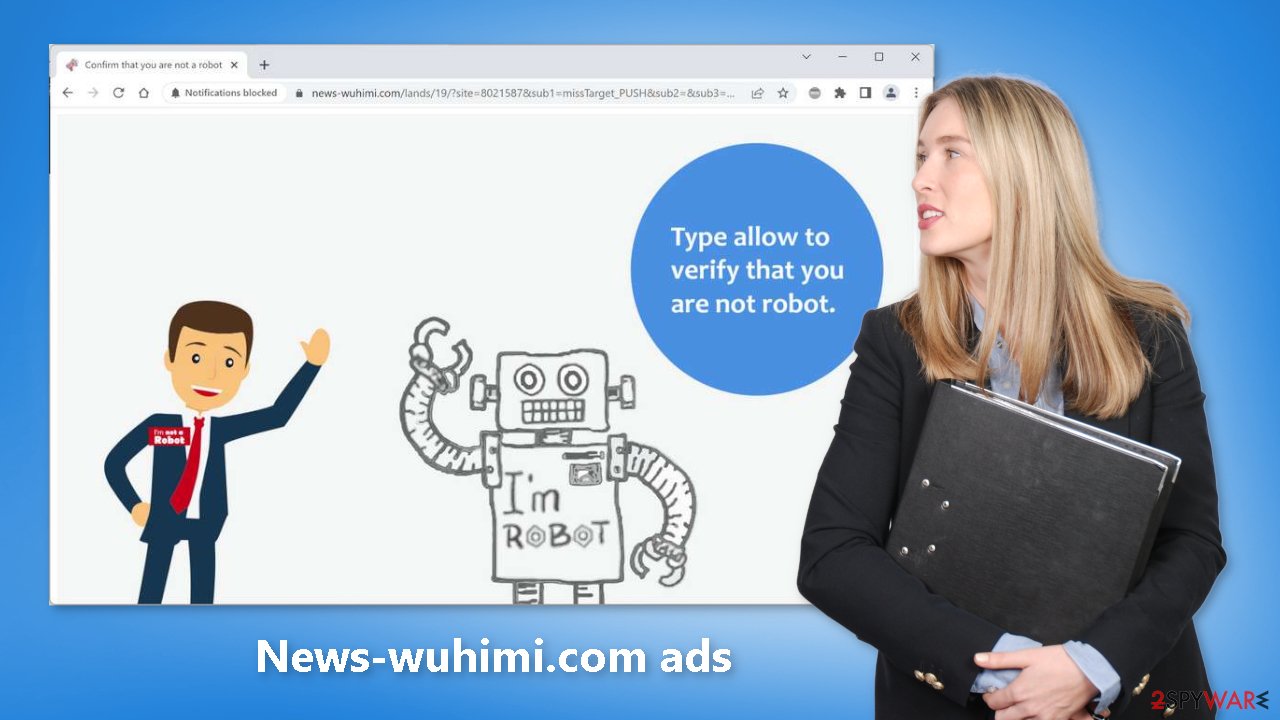News-wuhimi.com ads (spam) - Free Guide
News-wuhimi.com ads Removal Guide
What is News-wuhimi.com ads?
News-wuhimi.com is a fake website designed to trick people into subscribing to pop-up ads

News-wuhimi.com is a bogus website that attempts to dupe people into subscribing to push notifications by displaying the deceptive message “Type allow to verify that you are not a robot.” A professional-looking image of a man waving at a robot is also displayed.
When users click “Allow,” they are bombarded with annoying pop-up ads, which can appear even when the browser is closed. Furthermore, criminals may be using rogue advertising networks to place ads that lead to dangerous websites. If people click on the links embedded in the advertisements, they may end up on scam pages.
Users can be duped into providing personal information, downloading PUPs (potentially unwanted programs),[1] and even downloading malware. Users frequently notice ads promoting adult websites, bogus antivirus offers, giveaways, surveys, and so on. These pop-ups should be disabled as soon as possible.
| NAME | News-wuhimi.com |
| TYPE | Push notification spam; adware |
| SYMPTOMS | Pop-up ads start appearing in the corner of the screen |
| DISTRIBUTION | Shady websites, deceptive ads, freeware installations |
| DANGERS | The ads can contain links leading to dangerous websites where users could get tricked into providing their personal information or downloading PUPs and malware |
| ELIMINATION | Go to your browser settings to disable notifications |
| FURTHER STEPS | Use a maintenance tool FortectIntego to get rid of any remaining damage and clear your browsers |
Distribution methods
Pages like News-wuhimi.com are extremely rare in search results. They usually hide on other shady, unregulated pages. Illegal streaming sites, for example, are riddled with deceptive ads and sneaky redirects. They can also show fictitious “Play” and “Download” buttons.[2]
As a result, it is best to use legitimate streaming services such as Netflix or Hulu. They only require a small monthly subscription fee and allow users to consume as much content as they want while remaining safe. Do not click on random links and advertisements, even if they appear to promote legitimate products.
Freeware installations
Another possibility is that the site appeared on its own, without any user intervention. This can occur if users are infected with adware.[3] Advertising-supported software can cause unwanted symptoms such as pop-ups, banners, and redirects, and result in an increase in commercial content.
Adware is primarily distributed through freeware distribution platforms. They include in the installers additional programs that monetize user activity. Pay attention during the installation process and always select “Custom” or “Advanced” installation methods, as well as read the Privacy Policy and Terms of Use. The most important step is to go through the file list and untick any unrelated applications.

Remove browser pop-ups
To get rid of intrusive pop-up ads, you have to go to your browser settings and block the permission manually. The process is quite simple, as we show below:
Google Chrome (desktop):
- Open Google Chrome browser and go to Menu > Settings.
- Scroll down and click on Advanced.
- Locate the Privacy and security section and pick Site Settings > Notifications.
![Stop notifications on Chrome PC 1 Stop notifications on Chrome PC 1]()
- Look at the Allow section and look for a suspicious URL.
- Click the three vertical dots next to it and pick Block. This should remove unwanted notifications from Google Chrome.
![Stop notifications on Chrome PC 2 Stop notifications on Chrome PC 2]()
Google Chrome (Android):
- Open Google Chrome and tap on Settings (three vertical dots).
- Select Notifications.
- Scroll down to Sites section.
- Locate the unwanted URL and toggle the button to the left (Off setting).
![Stop notifications on Chrome Android Stop notifications on Chrome Android]()
Mozilla Firefox:
- Open Mozilla Firefox and go to Menu > Options.
- Click on Privacy & Security section.
- Under Permissions, you should be able to see Notifications. Click Settings button next to it.
![Stop notifications on Mozilla Firefox 1 Stop notifications on Mozilla Firefox 1]()
- In the Settings – Notification Permissions window, click on the drop-down menu by the URL in question.
- Select Block and then click on Save Changes. This should remove unwanted notifications from Mozilla Firefox.
![Stop notifications on Mozilla Firefox 2 Stop notifications on Mozilla Firefox 2]()
Safari:
- Click on Safari > Preferences…
- Go to Websites tab and, under General, select Notifications.
- Select the web address in question, click the drop-down menu and select Deny.
![Stop notifications on Safari Stop notifications on Safari]()
MS Edge:
- Open Microsoft Edge, and click the Settings and more button (three horizontal dots) at the top-right of the window.
- Select Settings and then go to Advanced.
- Under Website permissions, pick Manage permissions and select the URL in question.
![Stop notifications on Edge 1 Stop notifications on Edge 1]()
- Toggle the switch to the left to turn notifications off on Microsoft Edge.
![Stop notifications on Edge 2 Stop notifications on Edge 2]()
MS Edge (Chromium):
- Open Microsoft Edge, and go to Settings.
- Select Site permissions.
- Go to Notifications on the right.
- Under Allow, you will find the unwanted entry.
- Click on More actions and select Block.
![Stop notifications on Edge Chromium Stop notifications on Edge Chromium]()
Get rid of cookies and cache
It is best to avoid dubious pages that engage in illegal activities. Cookies can be used to track your IP address and geolocation. Websites can also collect information about your browsing habits, such as the websites you visit, the searches you conduct, what you buy online, and so on.
Cookies and cache are small data files that are stored in your system and can cause your device to slow down. After you've stopped the ads from appearing, we recommend cleaning up your browsers. FortectIntego will do it for you automatically. This will delete the information that websites have gathered about you and improve system performance.
Scan your system with anti-malware tools
If the previous removal method did not work, this one should. You must remove the app from your system that is causing the erratic behavior in the background. Using professional security tools such as SpyHunter 5Combo Cleaner or Malwarebytes would make the process much easier for you because they can automatically remove intruders by scanning your system. Manually doing it does not work for everyone because it is unclear which application is at fault.
However, if you still want to do this yourself, here are the step-by-step instructions:
Windows 10/8:
- Enter Control Panel into Windows search box and hit Enter or click on the search result.
- Under Programs, select Uninstall a program.
![Uninstall from Windows 1 Uninstall from Windows 1]()
- From the list, find the entry of the suspicious program.
- Right-click on the application and select Uninstall.
- If User Account Control shows up, click Yes.
- Wait till uninstallation process is complete and click OK.
![Uninstall from Windows 2 Uninstall from Windows 2]()
Windows 7/XP:
- Click on Windows Start > Control Panel located on the right pane (if you are Windows XP user, click on Add/Remove Programs).
- In Control Panel, select Programs > Uninstall a program.
![Uninstall from Windows 7/XP Uninstall from Windows 7/XP]()
- Pick the unwanted application by clicking on it once.
- At the top, click Uninstall/Change.
- In the confirmation prompt, pick Yes.
- Click OK once the removal process is finished.
macOS:
- From the menu bar, select Go > Applications.
- In the Applications folder, look for all related entries.
- Click on the app and drag it to Trash (or right-click and pick Move to Trash)
![Uninstall from Mac 1 Uninstall from Mac 1]()
To fully remove an unwanted app, you need to access Application Support, LaunchAgents, and LaunchDaemons folders and delete relevant files:
- Select Go > Go to Folder.
- Enter /Library/Application Support and click Go or press Enter.
- In the Application Support folder, look for any dubious entries and then delete them.
- Now enter /Library/LaunchAgents and /Library/LaunchDaemons folders the same way and terminate all the related .plist files.
![Uninstall from Mac 2 Uninstall from Mac 2]()
How to prevent from getting adware
Access your website securely from any location
When you work on the domain, site, blog, or different project that requires constant management, content creation, or coding, you may need to connect to the server and content management service more often. The best solution for creating a tighter network could be a dedicated/fixed IP address.
If you make your IP address static and set to your device, you can connect to the CMS from any location and do not create any additional issues for the server or network manager that needs to monitor connections and activities. VPN software providers like Private Internet Access can help you with such settings and offer the option to control the online reputation and manage projects easily from any part of the world.
Recover files after data-affecting malware attacks
While much of the data can be accidentally deleted due to various reasons, malware is one of the main culprits that can cause loss of pictures, documents, videos, and other important files. More serious malware infections lead to significant data loss when your documents, system files, and images get encrypted. In particular, ransomware is is a type of malware that focuses on such functions, so your files become useless without an ability to access them.
Even though there is little to no possibility to recover after file-locking threats, some applications have features for data recovery in the system. In some cases, Data Recovery Pro can also help to recover at least some portion of your data after data-locking virus infection or general cyber infection.
- ^ Chris Hoffman. PUPs Explained: What is a “Potentially Unwanted Program”?. Howtogeek. Technology Magazine.
- ^ Andy Maxwell. Google Targets Fake ‘Download’ and ‘Play’ Buttons. Torrentfreak. Filesharing News.
- ^ Adware. Malwarebytes. Cybersecurity Basics.














